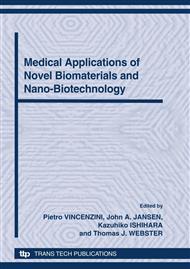[1]
N. Pugno: Nanotechnol., Vol. 17 (2006), p.5480.
Google Scholar
[2]
N. Pugno and A. Carpinteri: Phil. Mag. Lett., Vol. 88 (2008), p.397.
Google Scholar
[3]
N. Pugno: Mater. Today, Vol. 13 (2010), p.40.
Google Scholar
[4]
M.A.J. Cox, N.J.B. Driessen, R.A. Boerboom, C.V.C. Bouten and F.P.T. Baaijens. J. Biomech., Vol. 41 (2008), p.422.
Google Scholar
[5]
S.C. Cowin and S.B. Doty: Tissue mechanics (Springer, New York 2007).
Google Scholar
[6]
E. Baer, A. Hiltner and R. Morgan: Phys. Today, Vol. 45 (1992), p.60.
Google Scholar
[7]
F.T. Moutos, L.E. Freed and F. Guilaka: Nat Mater., Vol. 6 (2007), p.162.
Google Scholar
[8]
E. Traversa, B. Mecheri, C. Mandoli, S. Soliman, A. Rinaldi, S. Licoccia, G. Forte, F. Pagliari, S. Pagliari, F. Carotenuto, M. Minieri and P. Di Nardo:J. Exp. Nanosci., Vol. 3 (2008), p.97.
DOI: 10.1080/17458080701713946
Google Scholar
[9]
S.H. Ahn, Y.H. Koh and G.H. Kim: J. Micromech. Microeng., Vol. 20 (2010), 065015.
Google Scholar
[10]
R. Lakes: Nat., Vol. 361 (1993), p.511.
Google Scholar
[11]
R.F. Gibson: Principles of Composite Material Mechanics, first ed (McGraw-Hill, New York 1994).
Google Scholar
[12]
A. Bogdanovich and C. Pastore: Mechanics of Textile and Laminated Composites, first ed. (Chapman & Hall, London 1996).
Google Scholar
[13]
V.C. Mow, A. Radcliffe and SL-Y Woo: Biomechanics of Diarthroidal Joints, first ed. (Springer, New York 1990).
Google Scholar
[14]
R.M.V. Pidaparti, A. Chandran, Y. Takano and C.H. Turner: J. Biomech., Vol. 29 (1996), p.909.
Google Scholar
[15]
M. Paulsson, P.D. Yurchenco, G.C. Ruben, J. Engel and R. Timpl: J. Mol. Biol., Vol. 197 (1987), p.297.
Google Scholar
[16]
R.R. Lemos, M. Epstein and W. Herzog: Med. Biol. Eng. Comput., Vol. 46 (2008), p.23.
Google Scholar
[17]
K.M. Quapp and J.A. Weiss: Biomech. Eng., Vol. 120 (1998), p.757.
Google Scholar
[18]
H.A. Lynch, W. Johannessen, J.P. Wu, A. Jawa and D.M. Elliott: J. Biomech. Eng., Vol. 125 (2003), p.726.
Google Scholar
[19]
M. Lavagnino, S.P. Arnoczky, E. Kepich, O. Caballero and R.C. Haut: Biomech. Model. Mechan., Vol. 7 (2008), p.405.
Google Scholar
[20]
R. Fechete, D.E. Demco, B. Blumich, U. Eliav and G. Navon: J. Magn. Reson., Vol. 162 (2003), p.166.
Google Scholar


